Strap-free heart rate monitors offer comfort without sacrificing accuracy. Wrist-based options from Garmin, Apple, and Fitbit use PPG technology for reliable tracking during workouts, while armband monitors like Polar OH1+ provide near chest-strap accuracy with better stability during movement. Budget-friendly choices start at $39 with models like Amazfit Band 7 offering exceptional battery life. Your ideal monitor depends on your activity type, budget, and whether you need additional smartwatch features. Let’s explore your best options.
Why Choose Strap-Free Heart Rate Monitors?
While traditional chest strap monitors have long been considered the gold standard for heart rate tracking, strap-free monitors have revolutionized how we approach fitness tracking.
These convenient devices offer remarkable comfort for extended wear compared to chest straps, which is perfect if you’re tracking your heart rate throughout the day.
Unmatched comfort means all-day heart rate monitoring becomes effortless rather than a burden.
You’ll appreciate how quickly you can check your heart rate or start a workout without any extra preparation.
Most strap-free monitors are integrated into smartwatches or fitness trackers that serve multiple purposes beyond heart rate monitoring. They track your daily activities, sleep patterns, and even stress levels.
With wireless connectivity to your smartphone, you can easily review your real-time data and track your progress toward fitness goals, all while wearing a stylish accessory.
For those focusing on weight loss, these monitors help maintain appropriate heart rate zones to optimize fat burning during workouts.
Top Wrist-Based Heart Rate Monitors for Athletes
Athletes seeking reliable performance tracking will find wrist-based heart rate monitors to be invaluable training companions. While they’re typically less accurate than chest straps during high-intensity workouts, they offer unmatched convenience and continuous monitoring.
Garmin Forerunner stands out with its GPS capabilities and advanced fitness metrics, perfect for runners and triathletes. Apple Watch delivers sleek design with seamless iOS integration, while Fitbit provides more affordable options without sacrificing essential features.
For outdoor enthusiasts, Suunto and Coros watches offer robust construction and specialized training insights. These wrist-based monitors primarily use PPG technology to measure blood-flow readings through the skin. Most models feature optical sensors, water resistance, and compatibility with popular fitness apps.
You’ll appreciate the multi-functionality that combines heart rate tracking with GPS, notifications, and fitness level analysis—all conveniently worn on your wrist throughout your training day.
Budget-Friendly Optical Heart Rate Trackers
You’ll find surprisingly capable optical heart rate trackers that won’t break the bank, with options from Xiaomi, Amazfit, and Fitbit starting at just $39.
These budget-friendly wearables offer impressive value through essential features like continuous heart rate monitoring, multiple workout modes, and basic sleep tracking. The Amazfit Band 7 stands out as a top recommendation with its exceptional 12 to 28 days battery life performance.
Despite their affordable price points, many budget trackers boast vibrant AMOLED screens, decent water resistance, and battery life that lasts several days on a single charge.
Affordable Wrist-Based Options
When shopping for heart rate monitors on a budget, you don’t have to sacrifice quality for affordability. Several wallet-friendly options deliver reliable performance, especially during rest and moderate activity.
Xiaomi devices offer impressive value with MAPE values below 10%, making them suitable for casual fitness tracking. Garmin’s Vivosmart series provides slightly better accuracy with minimal underestimation (about 2 bpm) and higher concordance correlation coefficients than budget competitors.
The Scosche Rhythm matches the accuracy of pricier models like the Polar OH1 but costs considerably less. The COOSPO monitor delivers waterproof comfort with highly accurate readings while staying budget-friendly.
Just remember that all wrist-based monitors have limitations—they’re less reliable during high-intensity workouts and may produce occasional erroneous readings. Factors like darker skin tones and higher BMI can also affect accuracy, regardless of price point.
Value For Money Features
Budget-friendly optical heart rate trackers deliver impressive value by balancing essential features with affordability.
You’ll find impressive battery life across popular models—Xiaomi Mi Smart Band 7 offers 12 days, while Fitbit Inspire 3 and Amazfit Bip 5 provide 10 days each between charges.
Most budget options include colorful touchscreen displays (ranging from 0.76″ to 1.9″), customizable workout modes, and 50m water resistance.
While you won’t get clinical-grade accuracy during high-intensity workouts, these devices provide reliable readings for everyday fitness tracking. While not as precise as dedicated devices, these budget-friendly options still offer valuable heart rate insights for casual users.
For under $100, standout models like the Xiaomi Mi Smart Band 7 ($50) include SpO2 monitoring and 110+ workout modes, while the Amazfit Bip 5 ($89) offers built-in GPS.
These devices connect seamlessly with popular fitness apps through Bluetooth, eliminating chest strap discomfort.
Advanced Smartwatches With Heart Rate Capabilities
As technology continues to evolve, advanced smartwatches have emerged as powerful heart rate monitoring solutions that combine convenience with thorough health tracking.
While optical sensors aren’t as precise as chest straps, they offer impressive accuracy for daily use.
The Fitbit Versa 4 stands out as the best overall option, balancing features with affordability.
If you have smaller wrists, consider the compact Garmin Vivosmart 5.
Runners will appreciate the Garmin Forerunner 55’s specialized features, while the Apple Watch Series 8 offers seamless phone integration alongside health tracking.
The Garmin Venu 3 excels in extensive cardiovascular monitoring.
These devices go beyond basic heart rate tracking with integrated fitness apps, smart notifications, and additional health metrics like blood oxygen monitoring—all packed into comfortable, durable designs.
Monitoring your heart rate regularly can help detect early heart issues, including arrhythmias, and ensure you’re exercising at a safe intensity.
Armband Monitors: Performance and Comfort
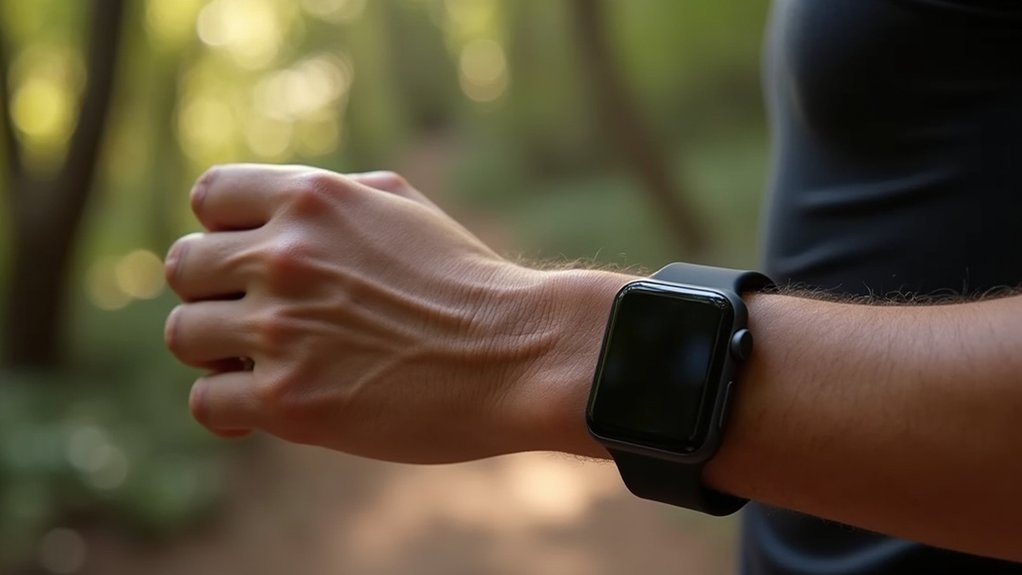
Armband heart rate monitors offer you superior optical sensor reliability compared to wrist-based devices, with models like Polar OH1+ and Scosche Rhythm24 delivering accuracy that approaches chest straps.
You’ll find these devices excel during athletic performance tracking by minimizing motion interference that typically plagues wrist-worn sensors during high-intensity workouts. These armbands use infrared light technology to detect blood volume changes through the skin with greater stability than wrist-worn alternatives.
The comfortable design distributes weight more evenly than chest straps, making armbands an ideal choice if you’re looking for extended wear comfort during prolonged training sessions.
Optical Sensor Reliability
When evaluating armband heart rate monitors, you’ll find that optical sensor reliability varies considerably across different devices and conditions.
The gold standard for accuracy is measured using Lin’s concordance correlation coefficient (CCC), with 0.8 or higher considered acceptable when compared to ECG readings.
While brands like Garmin have achieved impressive reliability scores of 0.92, others like Xiaomi trail with scores around 0.76.
You’ll experience better accuracy during rest than during intense exercise, when motion artifacts can interfere with readings. Armbands generally provide more stable positioning than wrist-worn devices, potentially improving reliability during movement. Recent research shows that wrist-worn devices’ accuracy significantly decreases at higher running speeds of 8-9 mph.
Your skin tone, moisture levels, and ambient lighting can all affect sensor performance.
For best results, verify your armband fits snugly without excessive pressure, as proper fit directly impacts reading accuracy.
Athletic Performance Tracking
Athletic performance tracking with armband heart rate monitors offers four key advantages over traditional chest straps and wrist-worn devices.
These monitors provide continuous heart rate data in nearly any environment using advanced sensor technology like PerformTek found in the Scosche Rhythm+ 2.0. The impressive 24-hour battery life ensures uninterrupted tracking throughout even the longest training sessions or events.
You’ll benefit from real-time feedback during workouts, allowing you to optimize training sessions by staying in target heart rate zones. Many models track calories burned based on your heart rate data, giving you a clearer picture of workout intensity.
The integration with multiple fitness apps provides in-depth performance analysis tools, helping you identify trends and improvements over time.
Whether you’re connecting to smartphones via Bluetooth or to bike computers with ANT+, these versatile monitors deliver the performance metrics serious athletes need without the discomfort of chest straps.
Extended Wear Comfort
For extended sessions where comfort becomes paramount, armband heart rate monitors excel with their ergonomic design and adaptive materials.
You’ll appreciate how these devices use breathable fabrics like neoprene, polyester, nylon, and spandex that prevent skin irritation during long workouts.
Most armbands feature adjustable straps that accommodate various arm sizes, ensuring a secure fit without uncomfortable pinching.
Whether worn on your bicep or forearm, they maintain stability without restricting movement.
What’s particularly impressive is their skin compatibility—optical sensors deliver accurate readings across all skin tones, eliminating variation based on complexion.
Models like the COROS offer durable elasticated bands that allow for personalized tension adjustment to maintain optimal contact with the skin without discomfort.
For intense training sessions, their sweat-resistant properties prevent slipping, while water-resistant designs stand up to humid conditions and intense perspiration.
This combination of comfort features means you can focus on performance rather than monitor discomfort.
Comparing Accuracy: Strap-Free vs. Traditional Monitors
Despite technological advances in wearable fitness devices, traditional chest straps still lead the pack in heart rate monitoring accuracy at 99.6% when worn properly.
Wrist-based monitors use photoplethysmography technology to measure heart rate through light reflection on the skin, unlike chest straps which use electrodes.
Apple Watch III perform admirably at rest and light exercise, achieving up to 96% agreement with ECG measurements.
However, you’ll notice diminishing accuracy as workout intensity increases. Wrist-worn devices drop below 70% accuracy at speeds of 8-9 mph.
Armbands offer a middle ground, typically outperforming wrist devices due to better positioning and fit.
Your personal characteristics matter too—BMI and non-white race can affect readings, while age and sex have minimal impact.
If you’re primarily doing high-intensity training, consider sticking with a chest strap. For everyday fitness tracking and moderate exercise, strap-free monitors provide sufficient accuracy with added comfort.
Best Heart Rate Monitors for Specific Sports
Choosing the right heart rate monitor for your sport can dramatically improve your training effectiveness.
For runners, the Garmin HRM Pro Plus and Polar H10 offer advanced metrics like stride length and cadence.
Swimmers should consider waterproof options such as the Garmin HRM-Pro Plus or Polar H10 with a swim clip.
Cyclists benefit from monitors with ANT+ compatibility like the Garmin HRM series or Wahoo Fitness products that seamlessly integrate with bike computers for real-time data during rides.
For triathletes needing versatile tracking across multiple disciplines, the Polar H10 provides superior accuracy with its third electrode technology and waterproof design.
Running and Jogging Selections
When selecting a heart rate monitor for running, comfort and accuracy become paramount during those long training sessions. Strap-free options like Wellue’s electrode patches offer continuous monitoring without chest constriction, perfect for distance runners who need up to 24 hours of battery life.
Wrist-based monitors from Fitbit and Apple Watch provide convenient tracking integrated with your existing devices. For those seeking alternatives, consider Garmin’s Forerunner or Polar’s Ignite, which deliver reliable readings without chest straps.
The best running monitors seamlessly integrate with your favorite apps, storing data while providing real-time feedback on your heart rate zones. These advanced monitors offer built-in vibration alerts when you exceed your target heart rate, helping runners maintain optimal training intensity.
You’ll appreciate customizable alerts that help maintain your target intensity and thorough post-run analysis to optimize your training program.
Swimming Tracker Options
Swimming demands a unique approach to heart rate monitoring, as water resistance and movement patterns create challenges for traditional trackers.
Fortunately, several options now exist for swimmers who want to ditch the chest strap.
The Polar OH1+ offers excellent accuracy and can be clipped to your goggles for convenient tracking.
If you prefer wrist-based monitoring, the Garmin Swim 2 provides real-time heart rate data during your swim sessions.
The Apple Watch Series 8, waterproof to 50m, delivers reliable readings for casual swimmers.
Research shows that optical sensors on wrist devices typically have reduced accuracy underwater due to water interference with skin contact.
When choosing a swimming heart rate monitor, consider waterproofing ratings, connectivity options, and display visibility underwater.
Remember that Bluetooth signals don’t transmit well through water, so look for devices that store data for post-swim analysis rather than relying on real-time transmission.
Cycling Monitoring Solutions
Cyclists face three primary options when selecting heart rate monitors that balance comfort with accuracy during rides.
Arm-band monitors like the COOSPO HW807 offer a compelling middle ground with Bluetooth/ANT+ connectivity, 20-hour battery life, and IP67 water resistance—ideal for sweaty or rainy rides.
Wrist-based options such as the ePulse 2 provide continuous readings without straps, though they’re typically less accurate during cycling due to motion and vibration. Many smartwatches in this category rely on optical sensors that use LED lights to measure heart rate through the skin.
These devices sacrifice some precision for convenience.
For serious training, consider arm monitors like Scosche Rhythm models that read from your upper arm rather than wrist, delivering more reliable data than typical wristbands.
When choosing, weigh your priorities between accuracy, comfort, and whether dual connectivity (Bluetooth/ANT+) is needed for your cycling setup.
The Technology Behind Strap-Free Monitoring
Modern heart rate monitoring has undergone a remarkable transformation with the advent of strap-free technology. Your wrist-based monitor uses advanced electro-optical cells and LED lights to track your heart rate continuously without the need for uncomfortable chest straps.
These innovative devices offer several key advantages:
- Real-time data collection through light-based sensors that detect blood flow patterns
- 24/7 monitoring capabilities that work seamlessly during various activities
- Customizable settings to match your specific fitness goals and preferences
- Comparable accuracy to traditional chest straps in most exercise conditions
While motion and environmental factors can occasionally affect readings, manufacturers continue improving these technologies to enhance reliability across different skin types and activities. Teachers and coaches can instantly gather and analyze performance data during PE classes, sports practice, and competitive events.
Battery Life and Charging Considerations
Three critical factors can make or break your heart rate monitoring experience: battery life, charging convenience, and power management. When selecting a strap-free monitor, consider these aspects carefully.
| Device | Battery Life | Charging Method | Best For |
|---|---|---|---|
| Wellue VisualBeat | 48 hours | USB | Multi-day use |
| Scosche Rhythm+2.0 | 24 hours | USB | Day-long activities |
| Mio Link | 7-10 hours | Magnetic | Intense workouts |
The Wellue VisualBeat leads with impressive 48-hour battery life, while the Scosche Rhythm+2.0 offers a solid 24 hours. For shorter workouts, the Mio Link’s 7-10 hours might suffice. Modern lithium batteries can withstand hundreds of charging cycles, though extreme temperatures and frequent charging will reduce longevity. Newer models feature more efficient power usage, ensuring you’ll spend less time charging and more time moving. Strapless monitors using electro-optical technology provide comfortable continuous readings without the restrictions of chest straps.
Water-Resistant Options for Swimmers
For dedicated swimmers seeking accurate heart rate data underwater, finding a truly water-resistant monitor presents unique challenges. Optical sensors typically struggle in water conditions, requiring devices specifically designed for aquatic use.
Underwater heart rate monitoring demands specialized equipment as standard optical sensors falter in aquatic environments.
When selecting a water-resistant heart rate monitor, prioritize these features:
- Look for IPX8 or higher water resistance ratings to guarantee reliability during extended submersion.
- Consider models like the Coros Pace 3 or specialized options like the Polar OH1+ that can attach to swim goggles.
- Check for advanced optical sensors with multiple LEDs that maintain accuracy despite water interference.
- Evaluate strap materials that won’t slip during vigorous swimming while remaining comfortable for long sessions.
Many Garmin and Apple Watch models offer respectable water resistance combined with swim-specific tracking features. The Polar Verity Sense is especially effective as it clips to goggle straps for temple readings that overcome typical water interference issues.
Data Analysis Features You Should Look For
When selecting a heart rate monitor, the data analysis capabilities often distinguish high-performance devices from basic options. Look for monitors offering detailed graphical representations that make trends easy to spot at a glance.
The best devices provide extensive statistics on heart rate variability and allow you to compare data across different workouts. For optimal accuracy during intense training sessions, consider devices that employ advanced signal filtering techniques to minimize motion artifacts. You’ll want customizable data views to focus on specific metrics that matter most to your training goals.
Ensure your monitor enables data export/import between platforms for thorough analysis. Many premium options integrate heart rate data with sleep and activity levels, giving you a more complete health picture.
While consumer devices deliver impressive accuracy (often 96% correlation with ECGs at rest), remember they’re not substitutes for medical-grade equipment if you need clinical monitoring.
How to Choose the Right Monitor for Your Needs
Finding your ideal heart rate monitor involves matching the device to your specific fitness goals and lifestyle requirements. When selecting a strap-free option, consider both accuracy and comfort for your particular activities.
- Assess your activity type – Continuous monitoring is vital for high-intensity workouts, while touch-based monitors might suffice for occasional checks during light exercise.
- Evaluate connectivity needs – Guarantee compatibility with your existing devices through Bluetooth or ANT+ and check if it works with your preferred fitness apps.
- Consider comfort factors – Look for breathable materials, ergonomic design, and adjustable sizing that suits your body type. Wrist-based monitors offer greater comfort than chest straps but typically provide less accurate heart rate measurements.
- Prioritize relevant features – Heart rate zone alerts might be essential for interval training, while GPS integration benefits outdoor enthusiasts.
Frequently Asked Questions
Can Strap-Free Monitors Track Heart Rate Accurately During High-Intensity Interval Training?
Most strap-free monitors struggle with accuracy during HIIT due to PPG technology limitations. You’ll get better results from ECG-based models like VisualBeat or advanced devices that maintain performance during intense movement.
How Do Medications Affect the Accuracy of Optical Heart Rate Monitors?
Medications affecting your circulation can reduce optical heart rate monitor accuracy. Diuretics, vasodilators, and vasoconstrictors alter blood flow to your skin, leading to weaker PPG signals and potentially unreliable or underestimated heart rate readings.
Are There Strap-Free Monitors Specifically Designed for Seniors?
Yes, you’ll find several strap-free monitors tailored for seniors. These devices offer simplified interfaces, larger displays, medication reminders, fall detection, and emergency alerts while providing comfortable, continuous heart monitoring without complicated straps.
Can These Monitors Detect Irregular Heartbeats or Potential Health Concerns?
Yes, some strap-free monitors can detect irregular heartbeats, but they’re less reliable than ECG devices. You’ll find Apple Watch and medical-grade optical monitors offer better arrhythmia detection than standard fitness trackers.
How Often Should Optical Heart Rate Sensors Be Cleaned?
You should clean optical heart rate sensors after workouts using fresh water and a soft cloth. You don’t need to deep clean them daily, but regular maintenance prevents dirt buildup and guarantees accurate readings.
In Summary
You’ve got plenty of strap-free heart rate monitors to choose from based on your specific needs. Whether you’re an athlete needing precision, a swimmer requiring waterproof gear, or a casual user on a budget, there’s an option for you. Consider battery life, data analysis features, and comfort before making your choice. The right monitor will seamlessly integrate into your fitness routine without the hassle of a chest strap.

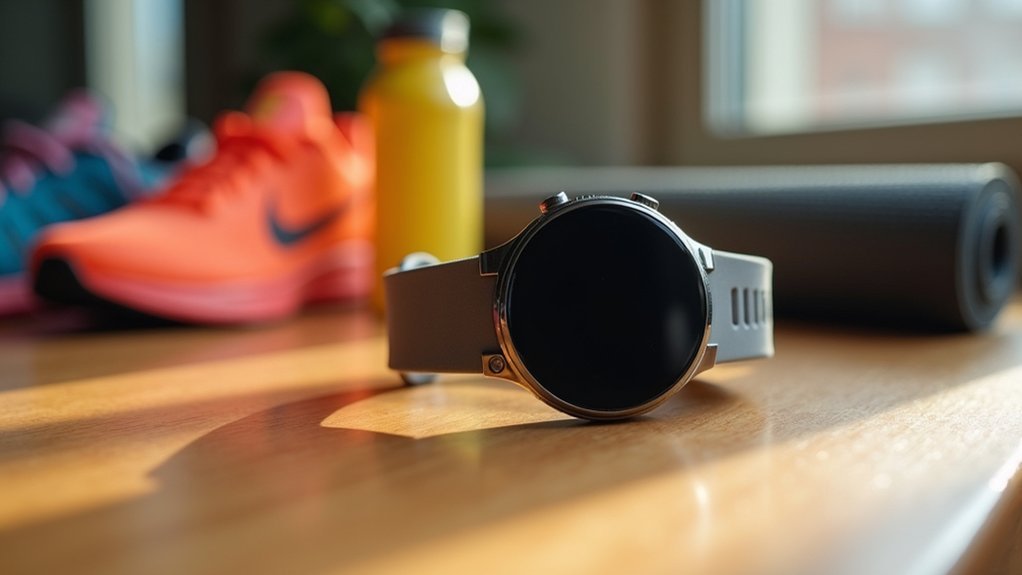
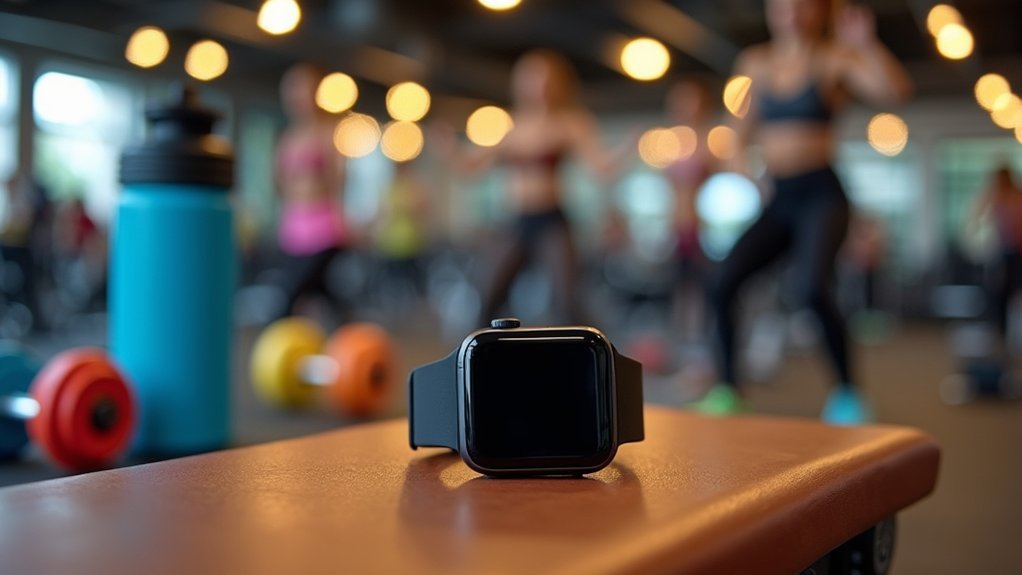
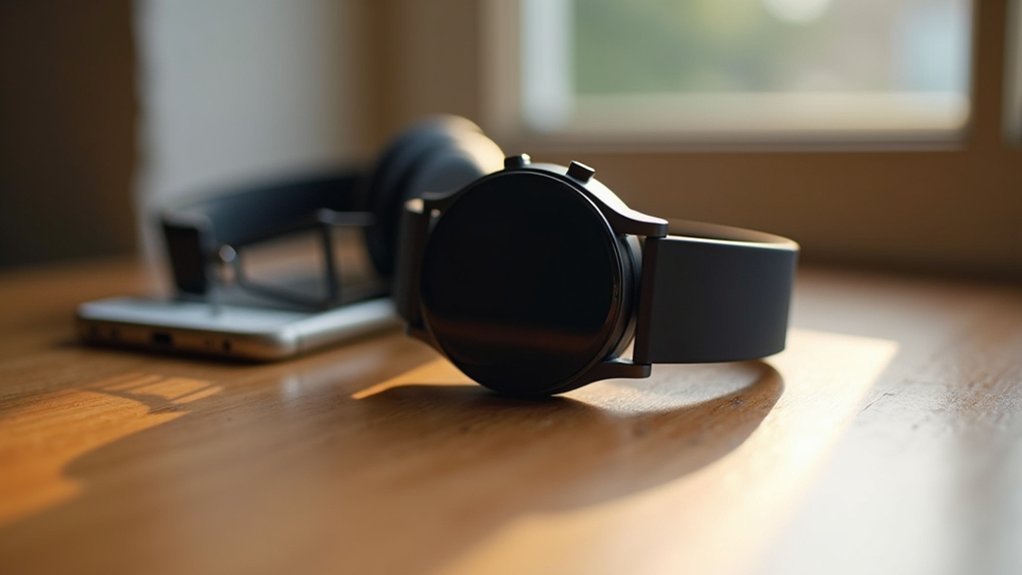
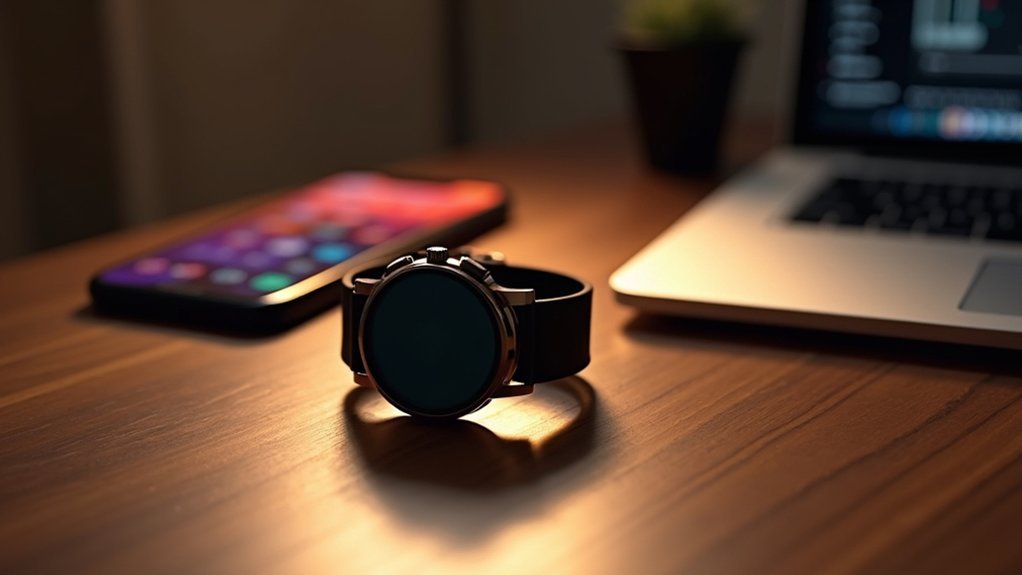
Leave a Reply